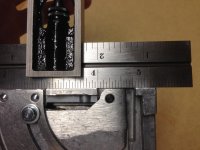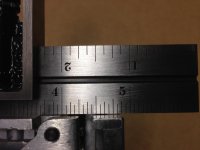promark747
Member
- Joined
- Jan 9, 2010
- Messages
- 469
Just bought a Domino, and have a question regarding the fence. I have noticed a slight twist or skew on the right side. This was present on all of the models at my dealer, so I don't think it is an issue unique to the one I bought. When I got home, I took some time to get more familiar with the machine, and here is what I noticed. First, there is a spring-loaded ball bearing on the right side that I believe is meant to keep light pressure on the fence as it slides. More importantly, when the height locking lever is tightened, it applies force only to the right side of the fence/pillar. When the locking lever is not engaged, the fence is perfectly parallel with the edge of the base (a ruler placed along the fence will contact the base and lay flat). However, as force is applied to the lever, I can clearly see it push the fence proud of the base (about 1-2 mm I'm guessing), leaving a gap between the ruler and the base. I don't think I am applying too much force, but will consider it a possibility.
I guess the question is whether this minor skew will affect the accuracy of the cuts (I have yet to make my first plunge) or if there is a trick to avoiding this twist. I assume that one shouldn't crank down on the lever, and have seen a suggestion to press the left side of the fence against the left pillar while locking the lever (which actually seems contrary to the way I think it should be pressed...I'm thinking you would want to push the left side of the fence forward to mimic the way the right fence is moving when the lever is tightened.)
Based on the Domino's design, I would think everyone's machine has the same issue (or non-issue). When I was looking at the DF700, I did notice that the height locking lever is designed differently, perhaps to avoid this uneven force.
In the end, I guess I should just start using my new Domino... ;D
Thanks,
Brian
I guess the question is whether this minor skew will affect the accuracy of the cuts (I have yet to make my first plunge) or if there is a trick to avoiding this twist. I assume that one shouldn't crank down on the lever, and have seen a suggestion to press the left side of the fence against the left pillar while locking the lever (which actually seems contrary to the way I think it should be pressed...I'm thinking you would want to push the left side of the fence forward to mimic the way the right fence is moving when the lever is tightened.)
Based on the Domino's design, I would think everyone's machine has the same issue (or non-issue). When I was looking at the DF700, I did notice that the height locking lever is designed differently, perhaps to avoid this uneven force.
In the end, I guess I should just start using my new Domino... ;D
Thanks,
Brian


